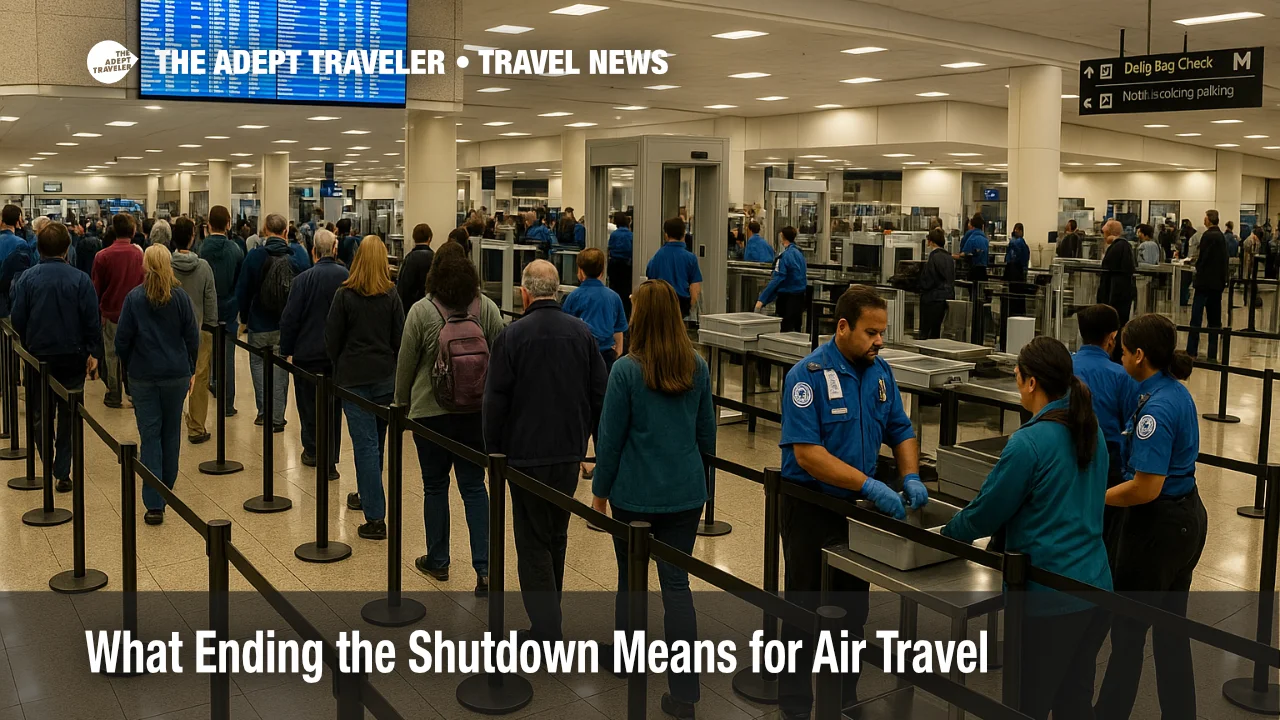What Ending the Shutdown Means for Air Travel

Key points
- The Senate advanced a House-passed bill Sunday night to reopen the government through January 30, clearing a path to end the 40-day shutdown
- FAA air traffic control attendance should rebound within 24 to 72 hours of pay and scheduling normalization, but the structural controller shortfall persists into 2026
- TSA staffing and checkpoint throughput should normalize within two to five days at most airports, with the longest lines easing first at major hubs
- Expect rolling ground delay programs and schedule trims to taper through midweek as facilities restaff and airlines rebuild rotations
Impact
- Rebooking Strategy
- Keep flexible tickets through Wednesday and avoid tight connections at the biggest hubs
- Airport Timing
- Arrive 30 to 60 minutes earlier than usual through midweek where long TSA lines were reported
- Connection Buffers
- Pad domestic connections to 90 minutes and international to two hours until operations stabilize
- Change Fees And Waivers
- Check airline travel waivers tied to FAA capacity reductions that may still apply early week
- Monitoring
- Track FAA delay programs and your airport's status the morning of travel
The path to reopening the federal government is now in view. On Sunday, November 9, the U.S. Senate voted 60 to 40 to advance a House-passed funding measure that would reopen agencies through January 30, following a 40-day shutdown that disrupted aviation operations and paychecks. If the measure clears its remaining steps, travelers should see a rapid improvement in staffing-driven delays at airports and in the air, with residual controls easing through the week.
What changed for aviation on Sunday night
The Senate's cloture vote set up final passage of a short-term funding bill that would restore pay and restart paused programs. That is the trigger aviation needed. During the shutdown, the Federal Aviation Administration, FAA, implemented traffic management initiatives and ordered schedule trims at dozens of airports to compensate for controller absences and facility constraints, while Transportation Security Administration, TSA, checkpoints in several cities saw multi-hour lines as unpaid officers called out. With a reopening bill moving, both agencies can recall staff to normal rosters and restart training and overtime assignments that were curtailed.
When air traffic control stabilizes
Controller attendance should improve quickly once pay is restored and schedules normalize, typically within 24 to 72 hours at most towers, TRACONs, and centers. That translates to a noticeable drop in staffing-driven ground delays by midweek if the bill becomes law in the next day or two. However, the deep structural gap in certified professional controllers does not vanish with a funding bill. The FAA's current plan calls for sustained hiring and training through at least 2028, and even before the shutdown the agency acknowledged shortages at multiple facilities that constrain throughput during peak periods. Bottom line, expect immediate relief from the shutdown's attendance shock, but do not expect pre-shortage capacity overnight.
Background, how controller staffing works
Controllers must complete academy training, then on-the-job certification at specific facilities, a process measured in months and years rather than days and weeks. Shutdowns pause parts of this pipeline and reduce overtime that helps cover vacations and medical leave. Reopening restores pay and overtime swiftly, but pipeline recovery takes time, which is why New York, Newark, Northern California, and a handful of other complexes may keep conservative traffic flows even after the government is funded.
When TSA returns to normal
TSA checkpoints tend to normalize faster than the ATC system. Once pay and schedules resume, absenteeism typically drops and managers can add overtime and surge teams to choke points. Expect the worst lines, reported last week at major hubs, to shorten within two to five days of reopening. Smaller airports that borrowed staff to support larger hubs could need a similar window to rebalance.
This week's traveler outlook
Monday to Tuesday. Airlines will still be flying trimmed schedules in some markets, and the FAA may keep ground delay programs at a subset of busy airports during morning and evening pushes. Build generous buffers, especially if you connect through New York area fields, Atlanta, Chicago, Houston, San Francisco, or Washington. TSA lines should begin to shorten, but plan extra time where three-hour queues were reported last week.
Wednesday. If the bill is signed and back pay is flowing, controller attendance and TSA staffing should look close to normal at most locations. Expect fewer ground stops, shorter departure metering times, and more reliable bank connections, although weather and lingering facility constraints can still trigger delays.
Thursday to Friday. Airlines should be largely back on published rotations, and the FAA can scale back extraordinary caps, leaving the underlying, longer-term staffing limitations as the main constraint in a few metroplexes. Travelers should still avoid 45-minute domestic connections and leave at least two hours for international transfers, both as a general best practice and as a hedge against pop-up traffic management during peaks.
Final thoughts
Ending the shutdown removes the single biggest variable that has been amplifying delays for 40 days. Expect a fast improvement in TSA lines and a steady reduction of staffing-driven ATC delays through midweek, with normal seasonal patterns, and the FAA's longer-term staffing limits, back in the driver's seat by late week. If your trip is early in the week, keep buffers and watch your airline app for reaccommodation options. If you depart after midweek, conditions should be close to normal barring weather.
Sources
- US Senate advances bill to end federal shutdown
- Government shutdown updates: Senate to reconvene Monday after vote advancing potential deal
- US Senate vote marks step towards ending federal shutdown
- Senate advances funding bill in breakthrough toward ending shutdown
- Airports seeing spike in shutdown impacts as TSA officers, air traffic controllers call out
- FAA Statement on Air Traffic Controller Staffing
- Air Traffic Controller Workforce Plan 2025-2028
- The air travel nightmare: TSA lines stretch for hours while airport workers go without pay
